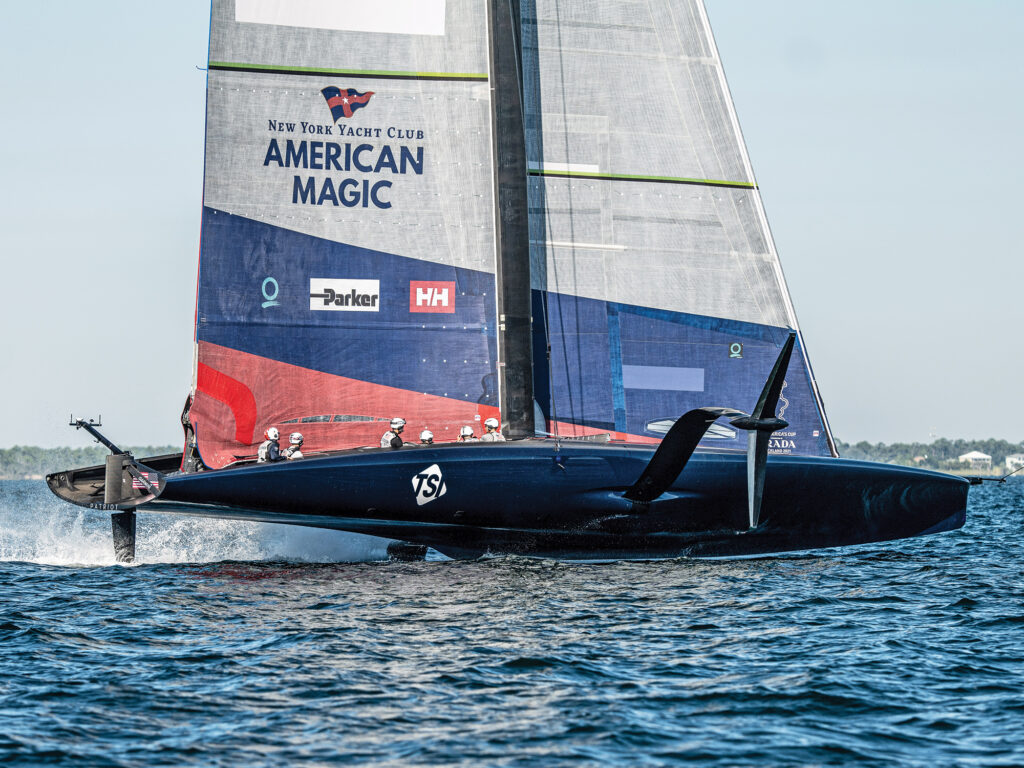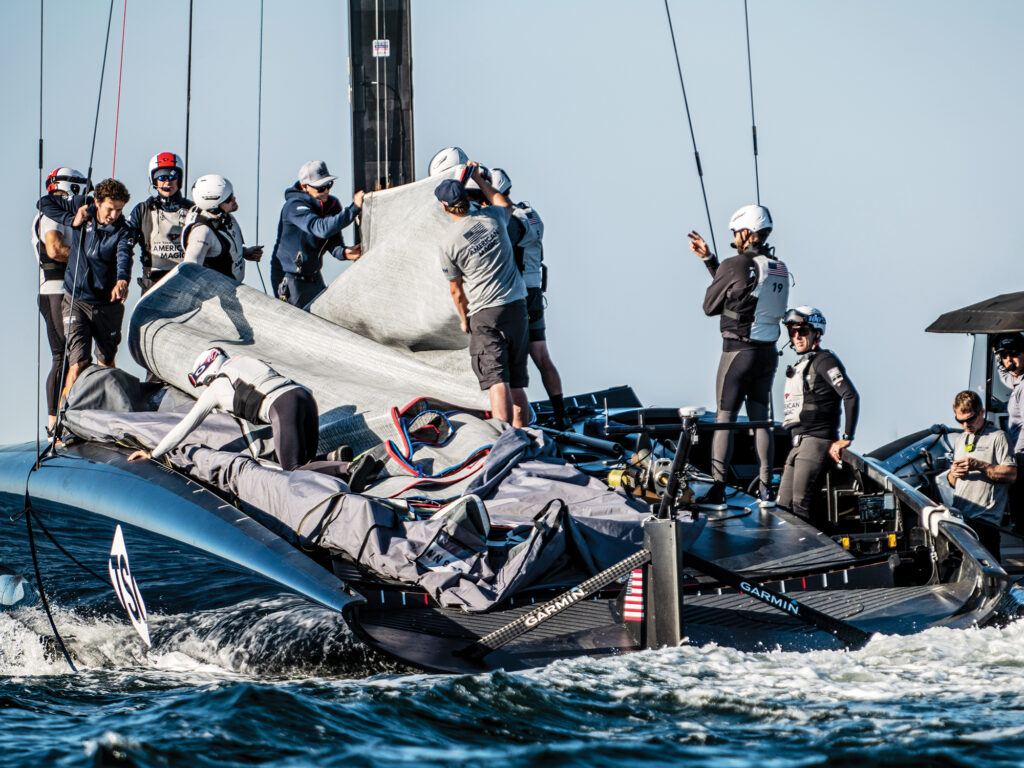Developments of the AC75 Mainsail
 Takeoff is the critical moment of an AC75, and there are many intricate steps to get there, says American Magic trimmer Lucas Calabrese.
Paul Todd / Outside Images
Takeoff is the critical moment of an AC75, and there are many intricate steps to get there, says American Magic trimmer Lucas Calabrese.
Paul Todd / Outside Images
As complex as the AC75s will be when launched for racing at the Louis Vuitton 37th America’s Cup Challenger Series, New York YC’s American Magic trimmer Lucas Calabrese says that getting the team’s 75-foot foiler around the racecourse will demand the same fundamentals he honed in his years of Olympic 470 sailing. A mainsail is a mainsail, after all, but how trimmers manage the power in these towering high-aspect sails is exponentially more critical. The AC75 Tech Regulations, which define virtually every aspect of the AC75, are “quite restrictive” with the sails, Calabrese says. But for the second-generation twin-skinned mainsails, there is plenty of innovation yet to come.
Most teams accept that Barcelona will be a generally lighter-wind venue, so most design packages will focus on performance in medium to light breezes. And when it comes to designing the “aero package” for these AC75s, the challenge is to have ample power in the sails for takeoff and minimal drag when up to speed. “These boats go very fast, and as soon as we’re going very fast, we need to get rid of a lot of area, which we can do,” Calabrese says. “But the hard part is that we also need to maneuver and need to accelerate. So, there’s no one solution to this challenge. It all relates to the rest of the package.”
That package, of course, includes foils, flaps, a rudder, rudder elevators, and countless other considerations. But for Calabrese, the main concern is the mainsail he’s tasked to trim with efficiency. The controls at his disposal include the mainsheet, which controls leech tension like any sailboat. Unlike a traditional keelboat, however, the AC75s have no booms. Given the high apparent wind angles at which these boats sail, booms are essentially unnecessary. With such narrow angles and no boom, Calabrese says that the mainsail could be considered as being more akin to a jib. The mainsheet simply impacts leech tension (on both mainsail skins), and then there’s the outhauls, which work similarly to a traditional outhaul. The cunningham system, he says, “is a pretty simple setup.” One additional consideration is mast rotation.
“Those are the main controls we use to set up the sails, and are important to controlling the boat’s heel angle,” Calabrese says. “But the most important tool to control the heel is the traveler. Heel is important because it’s all related to the foil-cant angle and to the flap, and to the stability of the boat.”
On the AC40s, used for pre-Cup development and preliminary regattas, the traveler system is battery-powered, so mainsail trimmers use it extensively. On the AC75, however, the traveler is powered by humans, the cyclors, so teams are more limited in the amount of traveler adjustments. “You just need to know how to use it wisely,” Calabrese says.
Outhaul adjustments are more micromovements, but because the clews are so close to the traveler itself, “the angle changes quite abruptly with small movements,” Calabrese says. “For every centimeter you move the outhaul track, you’re moving the angle, so you get a nice effect without having to move them too much.”
As for the cunningham, the loads are smaller to begin with at low speeds, but as speed builds, more travel in the system is required. The faster they go, the faster it changes; faster equals more load and more effort to pull, which requires more power from the cyclors.
Preliminary racing in the AC40s has demonstrated one of the most important elements of sailing an AC75: the takeoff. Initiating takeoff is one of the more challenging moments, Calabrese says, because the apparent wind angle during the acceleration phase is quite wide. The first thing they must do is rotate the mast fully to try to be as close as they can to the apparent wind angle. With maximum rotation, the traveler is pulled outboard.
“Because we don’t have a boom, it’s the only way to get the sail to set wider,” Calabrese explains. “So, basically, we’re trying to have good trim on [the main and jib], making sure that the two leeches are matched.”
As the speed builds, so too does the apparent wind as it shifts forward. “That’s when you start trimming on. And once we reach the boatspeed that we think we can pull up, that’s when we do the final trim up on the traveler. That will basically get us onto the foils, and once we’re on the foils, the speeds start going up really, really fast.”
At that point, he says, they’re looking to shed excess drag in the sails, using all the tools at their disposal (and this applies to the jib as well): cunninghams, outhauls and mast rotation. “Upwind, the apparent wind angle is about 13 degrees or so, and downwind really is not that much different,” Calabrese says. “So, basically, once we are up in the air, it’s about flattening the sails as much as we can.”
All of this, of course, requires tapping into the wattage output of the cyclors hammering away on their cranks. “We have the sensitivity of needing human power to move every sail control,” Calabrese says, “so we have to be mindful that if we’re moving the traveler all the time, the cyclors are not going to be happy.”
Takeoff is one thing, but the high-speed bear away at the top of the course is another. It’s the most difficult maneuver, especially uprange, Calabrese says. “Everything is very loaded, and we’re going very, very fast, so it’s all about timing. We have to be ready to time the helm really well because if you get to the point where the helmsman is going into the power zone and you start to heel to leeward, you can really start to lose it rapidly, which happens on an almost daily basis on the AC40s.”
 With “twin skins,” battens, internal components and hydraulic elements to manage, raising and lowering the mainsails of an AC75 is a full-team affair.
Paul Todd / Outside Images
With “twin skins,” battens, internal components and hydraulic elements to manage, raising and lowering the mainsails of an AC75 is a full-team affair.
Paul Todd / Outside Images
Success in the bear away is therefore all about being in precise synchronization. If the helmsman turns downwind and the boat is not properly depowered, leeward heel increases rapidly, and the point of no return is instant. “When you heel to leeward, you’re losing your righting moment quickly, and it snowballs. What happens next is the rudder comes out of the water, and then it’s over.”
Equally demanding on the power team and critical to being in sync is the turn through the bottom gate, especially when it’s windy. Going into the turn, the trimmers rely on software to tell them the time and distance to the turn. It’s also important that the cyclors know how far out they are from the mark—when things start getting pulled on and loaded, they’d better be ready for maximum output. The timing has to be right; pull things on too early, and VMG drops. Too late is too late. The sequence of events, Calabrese says, is cunningham on, outhauls adjusted, and then be prepared for the round up and acceleration. Mainsheet and jib-sheet adjustments happen in sync.
“The hardest part is to time things right so that you don’t end up with things trimmed on too early or too late,” he says.
And let’s not forget about the traveler; there’s a lot of big adjustments right after turning up, which draws a lot of energy from the cyclors. The cascading effect of any late adjustment is that other controls come on even later, which then requires even more traveler adjustments to follow. “Like every boat, if your sails are not in the right shape, you’re gonna end up way more unstable,” Calabrese says. “It’s similar here, so you want to make sure when you go around the mark, you can be pretty much set. It’s as much about managing the pressure from the cyclors as it is doing what you want. A lot of the time, you just can’t do what you wish to do.”
If the mainsail comes on too early and the jib late, the boat “gets pretty backloaded, and you can spin pretty quickly,” Calabrese adds. “Been there, done that. These are incredibly sensitive boats, regardless of how big they are. And we have to be very careful making sure we’re balanced because even though they’re big and heavy, they are still super-sensitive to being in the proper sail trim. The issues come when the helmsman turns and the sail trimmers are not ready or not ahead. That’s when you get into problems.”
The post Developments of the AC75 Mainsail appeared first on Sailing World.
- Home
- About Us
- Write For Us / Submit Content
- Advertising And Affiliates
- Feeds And Syndication
- Contact Us
- Login
- Privacy
All Rights Reserved. Copyright , Central Coast Communications, Inc.